Plasma 25-Hydroxyvitamin D Levels and VDR Gene Expression in Peripheral Blood Mononuclear Cells of Leukemia Patients and Healthy Subjects in Central Kazakhstan
Abstract
1. Introduction
2. Materials and Methods
2.1. Study Subjects
2.2. Blood Samples
2.3. Plasma 25(OH)D Assay
2.4. Isolation of Peripheral Blood Mononuclear Cells (PBMC)
2.5. Preparation of Total RNA and Quantitative Reverse Transcription Polymerase Chain Reaction (RT-qPCR)
2.6. Statistical Analysis
3. Results
4. Discussion
5. Conclusions
Supplementary Materials
Author Contributions
Funding
Conflicts of Interest
References
- Studzinski, G.P.; Harrison, J.S.; Wang, X.; Sarkar, S.; Kalia, V.; Danilenko, M. Vitamin D Control of Hematopoietic Cell Differentiation and Leukemia. J. Cell. Biochem. 2015, 116, 1500–1512. [Google Scholar] [CrossRef] [PubMed]
- Christakos, S.; Dhawan, P.; Verstuyf, A.; Verlinden, L.; Carmeliet, G. Vitamin D: Metabolism, Molecular Mechanism of Action, and Pleiotropic Effects. Physiol. Rev. 2016, 96, 365–408. [Google Scholar] [CrossRef] [PubMed]
- Carlberg, C.; Molnar, F. Vitamin D receptor signaling and its therapeutic implications: Genome-wide and structural view. Can. J. Physiol. Pharmacol. 2015, 93, 311–318. [Google Scholar] [CrossRef]
- Pike, J.W.; Meyer, M.B.; Lee, S.M.; Onal, M.; Benkusky, N.A. The vitamin D receptor: Contemporary genomic approaches reveal new basic and translational insights. J. Clin. Invest. 2017, 127, 1146–1154. [Google Scholar] [CrossRef]
- Lips, P. Relative value of 25(OH)D and 1,25(OH)2D measurements. J. Bone Miner. Res. 2007, 22, 1668–1671. [Google Scholar] [CrossRef]
- Bouillon, R. Comparative analysis of nutritional guidelines for vitamin D. Nat. Rev. Endocrinol. 2017, 13, 466–479. [Google Scholar] [CrossRef]
- Ross, A.C.; Manson, J.E.; Abrams, S.A.; Aloia, J.F.; Brannon, P.M.; Clinton, S.K.; Durazo-Arvizu, R.A.; Gallagher, J.C.; Gallo, R.L.; Jones, G.; et al. The 2011 report on dietary reference intakes for calcium and vitamin D from the Institute of Medicine: What clinicians need to know. J. Clin. Endocrinol. Metab. 2011, 96, 53–58. [Google Scholar] [CrossRef]
- Holick, M.F.; Binkley, N.C.; Bischoff-Ferrari, H.A.; Gordon, C.M.; Hanley, D.A.; Heaney, R.P.; Murad, M.H.; Weaver, C.M. Evaluation, treatment, and prevention of vitamin D deficiency: An Endocrine Society clinical practice guideline. J. Clin. Endocrinol. Metab. 2011, 96, 1911–1930. [Google Scholar] [CrossRef]
- van Schoor, N.M.; Lips, P. Worldwide vitamin D status. Best Pract Res. Clin. Endocrinol. Metab. 2011, 25, 671–680. [Google Scholar] [CrossRef]
- Holick, M.F.; Binkley, N.C.; Bischoff-Ferrari, H.A.; Gordon, C.M.; Hanley, D.A.; Heaney, R.P.; Murad, M.H.; Weaver, C.M. Guidelines for preventing and treating vitamin D deficiency and insufficiency revisited. J. Clin. Endocrinol. Metab. 2012, 97, 1153–1158. [Google Scholar] [CrossRef]
- Haq, A.; Svobodova, J.; Imran, S.; Stanford, C.; Razzaque, M.S. Vitamin D deficiency: A single centre analysis of patients from 136 countries. J. Steroid Biochem. Mol. Biol. 2016, 164, 209–213. [Google Scholar] [CrossRef]
- Mondul, A.M.; Weinstein, S.J.; Layne, T.M.; Albanes, D. Vitamin D and Cancer Risk and Mortality: State of the Science, Gaps, and Challenges. Epidemiol. Rev. 2017, 39, 28–48. [Google Scholar] [CrossRef]
- Wang, W.; Li, G.; He, X.; Gao, J.; Wang, R.; Wang, Y.; Zhao, W. Serum 25-hydroxyvitamin D levels and prognosis in hematological malignancies: A systematic review and meta-analysis. Cell. Physiol. Biochem. 2015, 35, 1999–2005. [Google Scholar] [CrossRef]
- Kulling, P.M.; Olson, K.C.; Olson, T.L.; Feith, D.J.; Loughran, T.P., Jr. Vitamin D in hematological disorders and malignancies. Eur. J. Haematol. 2017, 98, 187–197. [Google Scholar] [CrossRef]
- Radujkovic, A.; Schnitzler, P.; Ho, A.D.; Dreger, P.; Luft, T. Low serum vitamin D levels are associated with shorter survival after first-line azacitidine treatment in patients with myelodysplastic syndrome and secondary oligoblastic acute myeloid leukemia. Clin. Nutr. 2016. [Google Scholar] [CrossRef]
- Nugmanova, Z.; Patel, N.; Akhmetova, G.M.; Kurmangalieva, G.S.; Abdumananova, M.K.; Akanov, A.A.; Kovtunenko, N.G.; McNutt, L.A. Relationship between vitamin D and human immunodeficiency virus (HIV) viral load among HIV-infected patients in Kazakhstan. J. Infect. Dev. Ctries. 2015, 9, 1277–1283. [Google Scholar] [CrossRef][Green Version]
- Gromova, O.; Doschanova, A.; Lokshin, V.; Tuletova, A.; Grebennikova, G.; Daniyarova, L.; Kaishibayeva, G.; Nurpeissov, T.; Khan, V.; Semenova, Y.; et al. Vitamin D deficiency in Kazakhstan: Cross-Sectional study. J. Steroid Biochem. Mol. Biol. 2019, 199, 105565. [Google Scholar] [CrossRef]
- Igissinov, N.; Kulmirzayeva, D.; Moore, M.A.; Igissinov, S.; Baidosova, G.; Akpolatova, G.; Bukeyeva, Z.; Omralina, Y. Epidemiological assessment of leukemia in Kazakhstan, 2003–2012. Asian Pac. J. Cancer Prev. 2014, 15, 6969–6972. [Google Scholar] [CrossRef]
- Pesakhov, S.; Nachliely, M.; Barvish, Z.; Aqaqe, N.; Schwartzman, B.; Voronov, E.; Sharoni, Y.; Studzinski, G.P.; Fishman, D.; Danilenko, M. Cancer-selective cytotoxic Ca2+ overload in acute myeloid leukemia cells and attenuation of disease progression in mice by synergistically acting polyphenols curcumin and carnosic acid. Oncotarget 2016, 7, 31847–31861. [Google Scholar] [CrossRef]
- Livak, K.J.; Schmittgen, T.D. Analysis of relative gene expression data using real-time quantitative PCR and the 2−DDCT Method. Methods 2001, 25, 402–408. [Google Scholar] [CrossRef]
- Faul, F.; Erdfelder, E.; Lang, A.G.; Buchner, A. G*Power 3: A flexible statistical power analysis program for the social, behavioral, and biomedical sciences. Behav. Res. Methods 2007, 39, 175–191. [Google Scholar] [CrossRef]
- Foroni, L.; Wilson, G.; Gerrard, G.; Mason, J.; Grimwade, D.; White, H.E.; de Castro, D.G.; Austin, S.; Awan, A.; Burt, E.; et al. Guidelines for the measurement of BCR-ABL1 transcripts in chronic myeloid leukaemia. Br. J. Haematol. 2011, 153, 179–190. [Google Scholar] [CrossRef]
- Shakiyeva, R.; Abduldayeva, A.; Akhmetova, K.; Tuleshova, G.; Dosmambetova, K.; Maltabarova, N.; Kim, T.V.; Urazova, S.; Gatauova, M.; Orekesheva, A.; et al. The Structure of a Daily Food Ration of the Inhabitants Over 40 Years Old in the Republic of Kazakhstan. Iran. J. Public Health 2018, 47, 1215–1217. [Google Scholar]
- Lagunova, Z.; Porojnicu, A.C.; Lindberg, F.; Hexeberg, S.; Moan, J. The dependency of vitamin D status on body mass index, gender, age and season. Anticancer Res. 2009, 29, 3713–3720. [Google Scholar] [CrossRef]
- Oliai Araghi, S.; van Dijk, S.C.; Ham, A.C.; Brouwer-Brolsma, E.M.; Enneman, A.W.; Sohl, E.; Swart, K.M.; van der Zwaluw, N.L.; van Wijngaarden, J.P.; Dhonukshe-Rutten, R.A.; et al. BMI and Body Fat Mass Is Inversely Associated with Vitamin D Levels in Older Individuals. J. Nutr. Health Aging 2015, 19, 980–985. [Google Scholar] [CrossRef]
- Muscogiuri, G.; Barrea, L.; Somma, C.D.; Laudisio, D.; Salzano, C.; Pugliese, G.; de Alteriis, G.; Colao, A.; Savastano, S. Sex Differences of Vitamin D Status across BMI Classes: An Observational Prospective Cohort Study. Nutrients 2019, 11, 3034. [Google Scholar] [CrossRef]
- Carlberg, C.; Seuter, S.; de Mello, V.D.; Schwab, U.; Voutilainen, S.; Pulkki, K.; Nurmi, T.; Virtanen, J.; Tuomainen, T.P.; Uusitupa, M. Primary vitamin D target genes allow a categorization of possible benefits of vitamin D3 supplementation. PLoS ONE 2013, 8, 71042. [Google Scholar] [CrossRef]
- Neme, A.; Seuter, S.; Malinen, M.; Nurmi, T.; Tuomainen, T.P.; Virtanen, J.K.; Carlberg, C. In vivo transcriptome changes of human white blood cells in response to vitamin D. J. Steroid Biochem. Mol. Biol. 2019, 188, 71–76. [Google Scholar] [CrossRef]
- Kongsbak, M.; von Essen, M.R.; Boding, L.; Levring, T.B.; Schjerling, P.; Lauritsen, J.P.; Woetmann, A.; Odum, N.; Bonefeld, C.M.; Geisler, C. Vitamin D up-regulates the vitamin D receptor by protecting it from proteasomal degradation in human CD4+ T cells. PLoS ONE 2014, 9, 96695. [Google Scholar] [CrossRef]
- Coleman, L.A.; Mishina, M.; Thompson, M.; Spencer, S.M.; Reber, A.J.; Davis, W.G.; Cheng, P.Y.; Belongia, E.A.; Talbot, H.K.; Sundaram, M.E.; et al. Age, serum 25-hydroxyvitamin D and vitamin D receptor (VDR) expression and function in peripheral blood mononuclear cells. Oncotarget 2016, 7, 35512–35521. [Google Scholar] [CrossRef]
- Pludowski, P.; Grant, W.B.; Bhattoa, H.P.; Bayer, M.; Povoroznyuk, V.; Rudenka, E.; Ramanau, H.; Varbiro, S.; Rudenka, A.; Karczmarewicz, E.; et al. Vitamin D status in Central Europe. Int. J. Endocrinol. 2014, 2014, 589587. [Google Scholar] [CrossRef]
- Grant, W.B.; Bhattoa, H.P.; Boucher, B.J. Seasonal variations of U.S. mortality rates: Roles of solar ultraviolet-B doses, vitamin D, gene expression, and infections. J. Steroid Biochem. Mol. Biol. 2017, 173, 5–12. [Google Scholar] [CrossRef]
- Napoli, N.; Vattikuti, S.; Ma, C.; Rastelli, A.; Rayani, A.; Donepudi, R.; Asadfard, M.; Yarramaneni, J.; Ellis, M.; Armamento-Villareal, R. High prevalence of low vitamin D and musculoskeletal complaints in women with breast cancer. Breast J. 2010, 16, 609–616. [Google Scholar] [CrossRef][Green Version]
- Roffe-Vazquez, D.N.; Huerta-Delgado, A.S.; Castillo, E.C.; Villarreal-Calderon, J.R.; Gonzalez-Gil, A.M.; Enriquez, C.; Garcia-Rivas, G.; Elizondo-Montemayor, L. Correlation of Vitamin D with Inflammatory Cytokines, Atherosclerotic Parameters, and Lifestyle Factors in the Setting of Heart Failure: A 12-Month Follow-Up Study. Int. J. Mol. Sci. 2019, 20, 5811. [Google Scholar] [CrossRef]
- Halupczok-Zyla, J.; Jawiarczyk-Przybylowska, A.; Bolanowski, M. Patients with Active Acromegaly are at High Risk of 25(OH) D Deficiency. Front. Endocrinol. 2015, 6, 89. [Google Scholar]
- Touma, Z.; Eder, L.; Zisman, D.; Feld, J.; Chandran, V.; Rosen, C.F.; Shen, H.; Cook, R.J.; Gladman, D.D. Seasonal variation in vitamin D levels in psoriatic arthritis patients from different latitudes and its association with clinical outcomes. Arthritis Care Res. 2011, 63, 1440–1447. [Google Scholar] [CrossRef]
- Vaughan-Shaw, P.G.; O’Sullivan, F.; Farrington, S.M.; Theodoratou, E.; Campbell, H.; Dunlop, M.G.; Zgaga, L. The impact of vitamin D pathway genetic variation and circulating 25-hydroxyvitamin D on cancer outcome: Systematic review and meta-analysis. Br. J. Cancer 2017, 116, 1092–1110. [Google Scholar] [CrossRef]
- Grant, W.B. Review of Recent Advances in Understanding the Role of Vitamin D in Reducing Cancer Risk: Breast, Colorectal, Prostate, and Overall Cancer. Anticancer Res. 2020, 40, 491–499. [Google Scholar] [CrossRef]
- Lee, H.J.; Muindi, J.R.; Tan, W.; Hu, Q.; Wang, D.; Liu, S.; Wilding, G.E.; Ford, L.A.; Sait, S.N.; Block, A.W.; et al. Low 25(OH) vitamin D3 levels are associated with adverse outcome in newly diagnosed, intensively treated adult acute myeloid leukemia. Cancer 2014, 120, 521–529. [Google Scholar] [CrossRef]
- Thomas, X.; Chelghoum, Y.; Fanari, N.; Cannas, G. Serum 25-hydroxyvitamin D levels are associated with prognosis in hematological malignancies. Hematology 2011, 16, 278–283. [Google Scholar] [CrossRef]
- Fattizzo, B.; Zaninoni, A.; Giannotta, J.A.; Binda, F.; Cortelezzi, A.; Barcellini, W. Reduced 25-OH vitamin D in patients with autoimmune cytopenias, clinical correlations and literature review. Autoimmun. Rev. 2016, 15, 770–775. [Google Scholar] [CrossRef]
- Renne, C.; Benz, A.H.; Hansmann, M.L. Vitamin D3 receptor is highly expressed in Hodgkin’s lymphoma. BMC Cancer 2012, 12, 215. [Google Scholar] [CrossRef]
- Olson, K.C.; Kulling, P.M.; Olson, T.L.; Tan, S.F.; Rainbow, R.J.; Feith, D.J.; Loughran, T.P., Jr. Vitamin D decreases STAT phosphorylation and inflammatory cytokine output in T-LGL leukemia. Cancer Biol. Ther. 2016, 18, 290–303. [Google Scholar] [CrossRef]
- Gascoyne, D.M.; Lyne, L.; Spearman, H.; Buffa, F.M.; Soilleux, E.J.; Banham, A.H. Vitamin D Receptor Expression in Plasmablastic Lymphoma and Myeloma Cells Confers Susceptibility to Vitamin D. Endocrinology 2017, 158, 503–515. [Google Scholar] [CrossRef]
- Kenessary, D.; Kenessary, A.; Adilgireiuly, Z.; Akzholova, N.; Erzhanova, A.; Dosmukhametov, A.; Syzdykov, D.; Masoud, A.R.; Saliev, T. Air Pollution in Kazakhstan and Its Health Risk Assessment. Ann. Glob. Health 2019, 85, 133. [Google Scholar] [CrossRef]
- Heath, A.K.; Kim, I.Y.; Hodge, A.M.; English, D.R.; Muller, D.C. Vitamin D Status and Mortality: A Systematic Review of Observational Studies. Int. J. Environ. Res. Public Health 2019, 16, 383. [Google Scholar] [CrossRef]
- Manson, J.E.; Cook, N.R.; Lee, I.M.; Christen, W.; Bassuk, S.S.; Mora, S.; Gibson, H.; Gordon, D.; Copeland, T.; D’Agostino, D.; et al. Vitamin D Supplements and Prevention of Cancer and Cardiovascular Disease. N. Engl. J. Med. 2019, 380, 33–44. [Google Scholar] [CrossRef]
- Scragg, R. The Vitamin D Assessment (ViDA) study - Design and main findings. J. Steroid Biochem. Mol. Biol. 2019, 198, 105562. [Google Scholar] [CrossRef]
- Keum, N.; Lee, D.H.; Greenwood, D.C.; Manson, J.E.; Giovannucci, E. Vitamin D supplementation and total cancer incidence and mortality: A meta-analysis of randomized controlled trials. Ann. Oncol. 2019, 30, 733–743. [Google Scholar] [CrossRef]
- Ammann, E.M.; Drake, M.T.; Haraldsson, B.; Wallace, R.B.; Johnson, K.C.; Desai, P.; Lin, E.M.; Link, B.K. Incidence of hematologic malignancy and cause-specific mortality in the Women’s Health Initiative randomized controlled trial of calcium and vitamin D supplementation. Cancer 2017, 123, 4168–4177. [Google Scholar] [CrossRef] [PubMed]
- Madden, J.M.; Murphy, L.; Zgaga, L.; Bennett, K. De novo vitamin D supplement use post-diagnosis is associated with breast cancer survival. Breast Cancer Res. Treat. 2018, 172, 179–190. [Google Scholar] [CrossRef] [PubMed]
- Paubelle, E.; Zylbersztejn, F.; Alkhaeir, S.; Suarez, F.; Callens, C.; Dussiot, M.; Isnard, F.; Rubio, M.T.; Damaj, G.; Gorin, N.C.; et al. Deferasirox and vitamin D improves overall survival in elderly patients with acute myeloid leukemia after demethylating agents failure. PLoS ONE 2013, 8, 65998. [Google Scholar] [CrossRef] [PubMed]
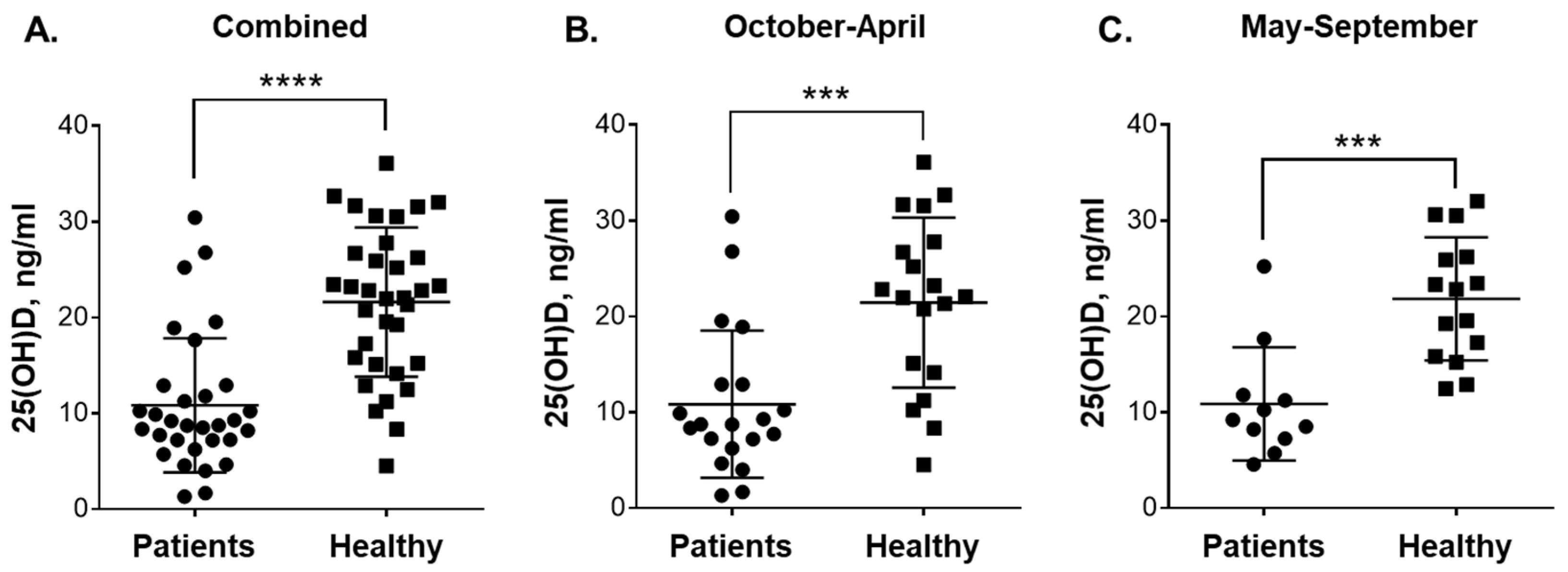
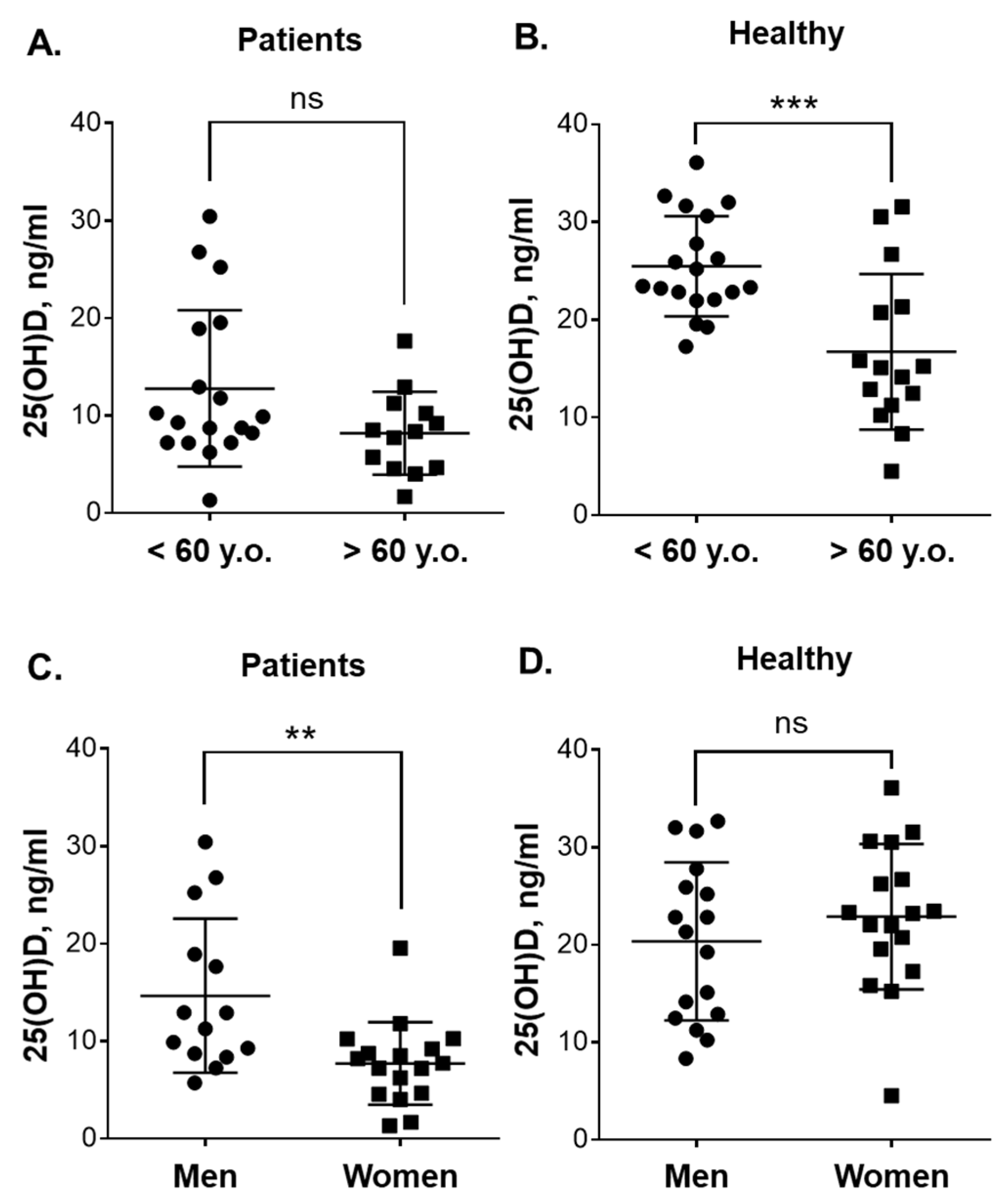
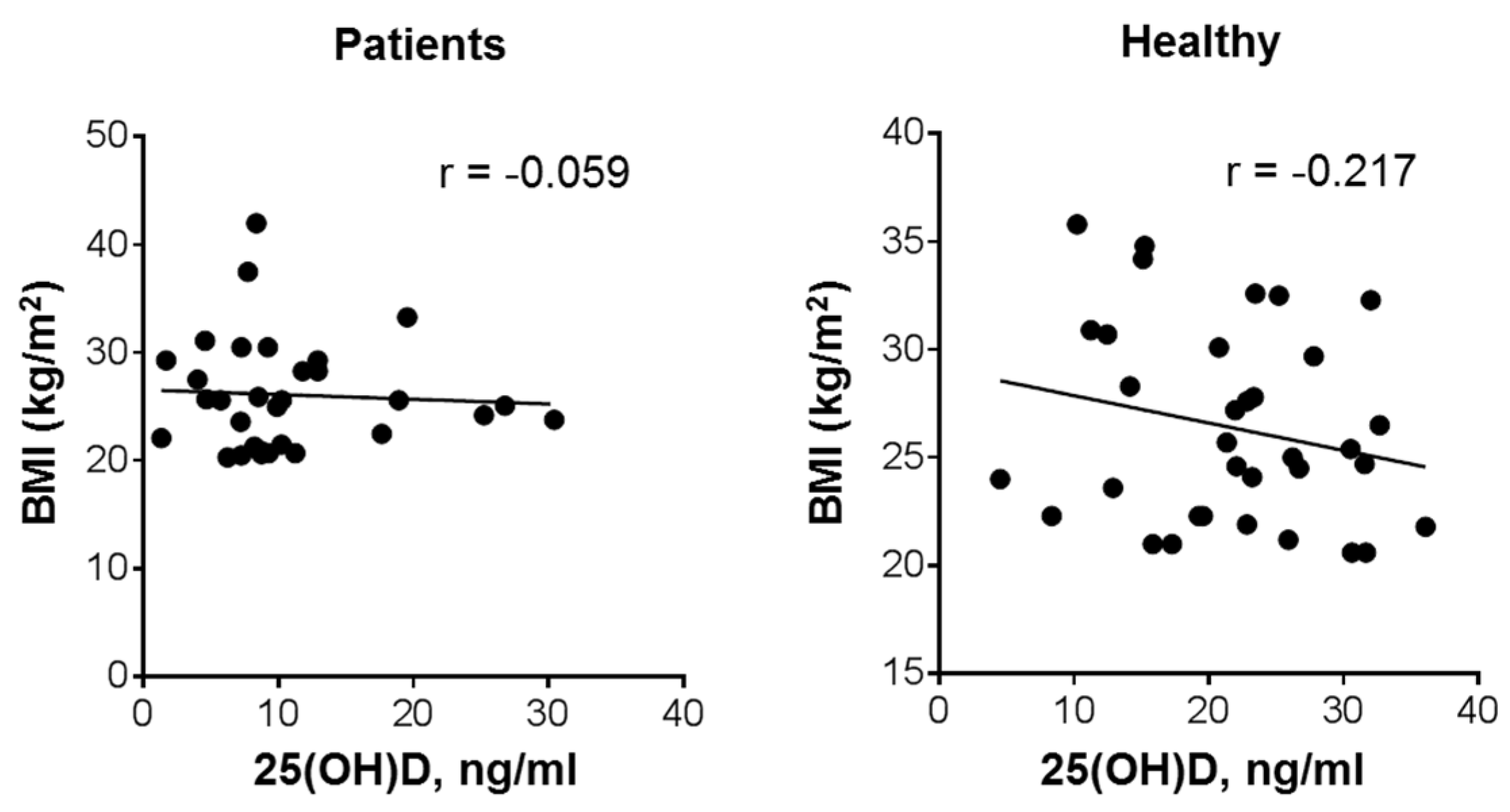
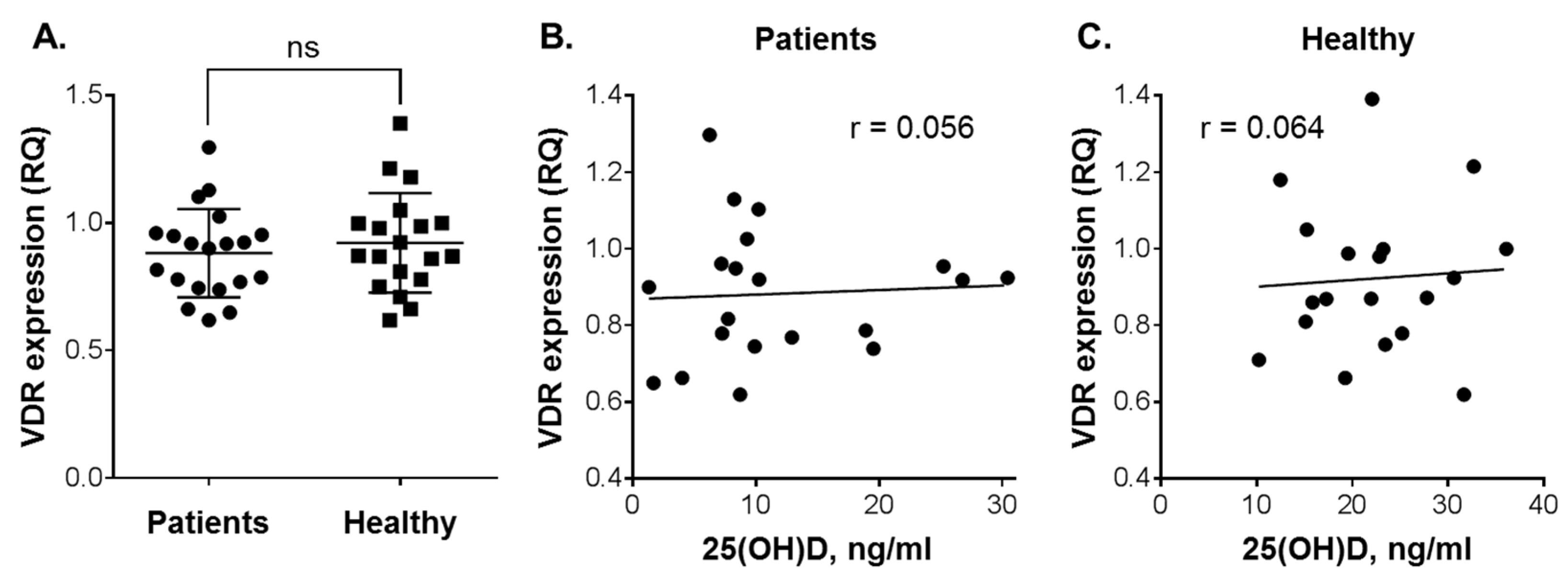
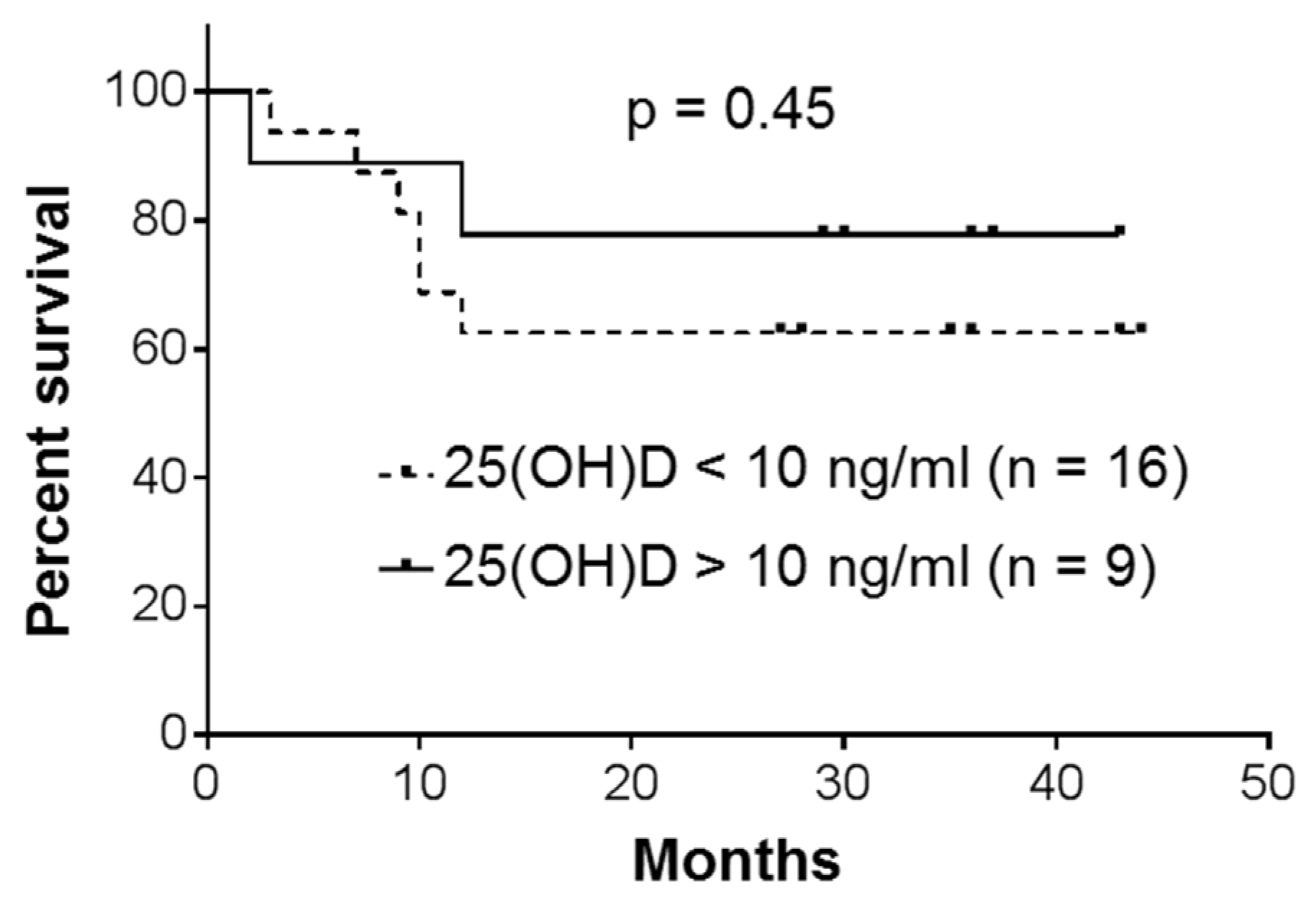
| No. | Sex | Age | Ethnicity | BMI a | Tobacco Use | 25(OH)D ng/mL | 25(OH)D Test Date | VDR b (RQ) c | Diagnosis | Clinical/Laboratory Data | Treatment | Survival (Months) j |
|---|---|---|---|---|---|---|---|---|---|---|---|---|
| 1 | F | 40 | Caucasian | 22.1 | No | 1.31 | March 2016 | 0.90 | CML e | Bcr-Abl transcript; chronic phase; myeloid hyperplasia, leukocytosis (>100 × 109 WBC i/L) | Nilotinib | LTS k |
| 2 | F | 78 | Asian | 29.3 | No | 1.67 | March 2016 | 0.65 | CML | Bcr-Abl transcript; chronic phase; myeloid hyperplasia, leukocytosis (>100 × 109 WBC/L) | Nilotinib | 10 |
| 3 | F | 61 | Caucasian | 27.5 | No | 4.00 | March 2016 | 0.66 | CML | Bcr-Abl transcript; chronic phase; myeloid hyperplasia, leukocytosis (>100 × 109 WBC/L) | Nilotinib | LTS |
| 4 | F | 78 | Asian | 31.1 | No | 4.55 | June 2017 | ND d | CML | Bcr-Abl transcript; chronic phase; myeloid hyperplasia, leukocytosis (>100 × 109 WBC/L) | Imatinib | 10 |
| 5 | M | 85 | Caucasian | 25.6 | No | 5.72 | June 2017 | ND | CML | Bcr-Abl transcript; chronic phase; myeloid hyperplasia, leukocytosis (>100 × 109 WBC/L) | Imatinib | 3 |
| 6 | F | 48 | Asian | 20.3 | No | 6.24 | February 2016 | 1.30 | CML | Bcr-Abl transcript; chronic phase; myeloid hyperplasia, leukocytosis (>100 × 109 WBC/L) | Nilotinib | LTS |
| 7 | F | 46 | Caucasian | 23.6 | No | 7.19 | March 2016 | 0.96 | CML | Bcr-Abl transcript; chronic phase; myeloid hyperplasia, leukocytosis (>100 × 109 WBC/L) | Nilotinib | LTS |
| 8 | F | 53 | Caucasian | 20.5 | No | 7.24 | June 2017 | 0.78 | CML | Bcr-Abl transcript; chronic phase; myeloid hyperplasia, leukocytosis (>100 × 109 WBC/L) | Imatinib | LTS |
| 9 | F | 39 | Caucasian | 21.3 | No | 8.22 | May 2017 | 1.13 | CML | Bcr-Abl transcript; chronic phase; myeloid hyperplasia, leukocytosis (>100 × 109 WBC/L) | Imatinib | LTS |
| 10 | F | 65 | Caucasian | 42.0 | Yes | 8.36 | October 2016 | 0.95 | CML | Bcr-Abl transcript; chronic phase; myeloid hyperplasia, leukocytosis (>100 × 109 WBC/L) | Imatinib | 9 |
| 11 | F | 68 | Asian | 25.9 | No | 8.51 | June 2017 | ND | CML | Bcr-Abl transcript; chronic phase; myeloid hyperplasia, leukocytosis (>100 × 109 WBC/L) | Nilotinib | 12 |
| 12 | M | 28 | Caucasian | 20.9 | No | 8.72 | November 2016 | 0.62 | CML | Bcr-Abl transcript; chronic phase; myeloid hyperplasia, leukocytosis (>100 × 109 WBC/L) | Imatinib | LTS |
| 13 | F | 53 | Asian | 20.6 | No | 8.74 | December 2016 | ND | CML | Bcr-Abl transcript; chronic phase; myeloid hyperplasia, leukocytosis (>100 × 109 WBC/L) | Nilotinib | LTS |
| 14 | F | 62 | Asian | 30.5 | No | 9.20 | June 2017 | ND | CML | Bcr-Abl transcript; chronic phase; myeloid hyperplasia, leukocytosis (>100 × 109 WBC/L) | Imatinib | LTS |
| 15 | M | 56 | Asian | 20.7 | Yes | 9.27 | February 2016 | 1.03 | CML | Bcr-Abl transcript; chronic phase; myeloid hyperplasia, leukocytosis (>100 × 109 WBC/L) | Hydroxyurea | LTS |
| 16 | M | 57 | Caucasian | 25.0 | Yes | 9.89 | April 2016 | 0.75 | CML | Bcr-Abl transcript; chronic phase; myeloid hyperplasia, leukocytosis (>100 × 109 WBC/L) | Imatinib | 7 |
| 17 | M | 39 | Asian | 25.6 | No | 10.25 | June 2017 | 0.92 | CML | Bcr-Abl transcript; chronic phase; myeloid hyperplasia, leukocytosis (>100 × 109 WBC/L) | Nilotinib | LTS |
| 18 | M | 65 | Asian | 20.7 | Yes | 11.25 | May 2017 | ND | CML | Bcr-Abl transcript; chronic phase; myeloid hyperplasia, leukocytosis (>100 × 109 WBC/L) | Imatinib | LTS |
| 19 | F | 53 | Asian | 28.3 | No | 11.79 | June 2017 | ND | CML | Bcr-Abl transcript; chronic phase; myeloid hyperplasia, leukocytosis (>100 × 109 WBC/L) | Nilotinib | LTS |
| 20 | M | 72 | Caucasian | 28.3 | Yes | 12.92 | February 2016 | 0.77 | CML | Bcr-Abl transcript; chronic phase; myeloid hyperplasia, leukocytosis (>100 × 109 WBC/L) | Imatinib | 12 |
| 21 | M | 58 | Caucasian | 29.3 | Yes | 12.92 | November 2016 | ND | CML | Bcr-Abl transcript; chronic phase; myeloid hyperplasia, leukocytosis (>100 × 109 WBC/L) | Nilotinib | LTS |
| 22 | M | 76 | Asian | 22.5 | Yes | 17.65 | May 2017 | ND | CML | Bcr-Abl transcript; chronic phase; myeloid hyperplasia, leukocytosis (>100 × 109 WBC/L) | Nilotinib | 1 |
| 23 | M | 42 | Asian | 25.6 | Yes | 18.91 | April 2016 | 0.79 | CML | Bcr-Abl transcript; chronic phase; myeloid hyperplasia, leukocytosis (>100 × 109 WBC/L) | Imatinib | LTS |
| 24 | M | 43 | Asian | 24.2 | Yes | 25.22 | June 2017 | 0.95 | CML | Bcr-Abl transcript; chronic phase; myeloid hyperplasia, leukocytosis (>100 × 109 WBC/L) | Nilotinib | LTS |
| 25 | M | 43 | Caucasian | 25.1 | Yes | 26.78 | October 2016 | 0.92 | CML | Bcr-Abl transcript; chronic phase; myeloid hyperplasia, leukocytosis (>100 × 109 WBC/L) | Imatinib | LTS |
| 26 | F | 73 | Caucasian | 25.7 | No | 4.66 | December 2016 | ND | AML f | Low bone marrow (BM) cellularity; ~52% blasts in the BM; myelosuppression | Cytarabine + doxorubicin | 1 |
| 27 | F | 68 | Asian | 21.5 | No | 10.22 | November 2016 | 1.10 | AML | Low BM cellularity; ~50% blasts in the BM; myelosuppression; breast cancer 2 years before AML | Cytarabine + doxorubicin | 3 |
| 28 | F | 54 | Caucasian | 33.3 | No | 19.53 | February 2016 | 0.74 | AML | Low BM cellularity; ~45% blasts in the BM; myelosuppression. M0 subtype with CD7 co-expression | Cytarabine + doxorubicin | 3 |
| 29 | M | 59 | Caucasian | 23.8 | Yes | 30.43 | December 2016 | 0.92 | AML | Low BM cellularity; ~51% blasts in the BM; myelosuppression | Cytarabine + doxorubicin | 3 |
| 30 | M | 59 | Asian | 30.5 | Yes | 7.24 | March 2016 | ND | CLL g | B-cell CLL (CD19+/CD5+/CD23−/CD200+/CD22+/CD20+/CD43+/CD38+/CD79b−/CD10−/FMC7−); leukocytosis (17,000 WBC/µl) with absolute lymphocytosis; ~2% prolymphocytes and 9% atypical lymphocytes in the blood; moderate BM cellularity. | Imatinib | LTS |
| 31 | F | 68 | Caucasian | 37.5 | No | 7.74 | March 2016 | 0.82 | ALL h | Pre-B (BIII) ALL (cytIgM+/sIgM−/CD19+/CD10+/CD34+/HLADR+/cytCD22+/ sCD22dim/CD20dim/CD7−/CD13−/CD33−/MPO−); ~44% blasts in the BM; low BM cellularity. | Imatinib | 1 |
| Men | Women | ||||||||||||
|---|---|---|---|---|---|---|---|---|---|---|---|---|---|
| No. | Age | Ethnicity | BMI | Tobacco Use | 25(OH)D ng/mL | 25(OH)D Test Date | No. | Age | Ethnicity | BMI | Tobacco Use | 25(OH)D ng/mL | 25(OH)D Test Date |
| 1 | 71 | Caucasian | 22.3 | No | 8.34 | October 2017 | 18 | 78 | Caucasian | 24.0 | No | 4.52 | December 2016 |
| 2 | 74 | Caucasian | 35.8 | Yes | 10.23 | March 2016 | 19 | 71 | Caucasian | 34.8 | No | 15.23 | June 2017 |
| 3 | 68 | Asian | 30.9 | Yes | 11.24 | April 2017 | 20 | 70 | Caucasian | 21.0 | No | 15.84 | May 2016 |
| 4 | 68 | Asian | 30.7 | Yes | 12.46 | June 2017 | 21 | 26 | Caucasian | 21.0 | No | 17.26 | July 2016 |
| 5 | 65 | Asian | 23.6 | Yes | 12.88 | May 2016 | 22 | 55 | Asian | 22.3 | No | 19.56 | May 2016 |
| 6 | 60 | Caucasian | 28.3 | Yes | 14.15 | February 2016 | 23 | 64 | Caucasian | 30.1 | No | 20.75 | February 2017 |
| 7 | 63 | Asian | 34.2 | No | 15.11 | November 2016 | 24 | 42 | Asian | 27.2 | No | 21.95 | October 2017 |
| 8 | 48 | Asian | 22.3 | No | 19.26 | May 2017 | 25 | 33 | Asian | 24.6 | No | 22.05 | November 2016 |
| 9 | 77 | Caucasian | 25.7 | No | 21.34 | April 2016 | 26 | 35 | Caucasian | 24.1 | No | 23.21 | November 2017 |
| 10 | 52 | Asian | 21.9 | No | 22.83 | October 2016 | 27 | 36 | Asian | 27.8 | No | 23.33 | September 2016 |
| 11 | 48 | Asian | 27.6 | No | 22.84 | May 2016 | 28 | 36 | Asian | 32.6 | No | 23.45 | June 2017 |
| 12 | 32 | Caucasian | 32.5 | Yes | 25.20 | April 2017 | 29 | 52 | Asian | 25.0 | No | 26.23 | June 2016 |
| 13 | 48 | Asian | 21.2 | Yes | 25.90 | June 2016 | 30 | 63 | Asian | 24.5 | No | 26.70 | March 2017 |
| 14 | 53 | Caucasian | 29.7 | Yes | 27.80 | October 2016 | 31 | 68 | Asian | 25.4 | No | 30.53 | June 2017 |
| 15 | 58 | Asian | 20.6 | No | 31.66 | April 2016 | 32 | 53 | Caucasian | 20.6 | No | 30.63 | June 2016 |
| 16 | 41 | Asian | 32.3 | Yes | 32.02 | June 2016 | 33 | 75 | Asian | 24.7 | No | 31.56 | April 2016 |
| 17 | 48 | Asian | 26.5 | No | 32.68 | October 2016 | 34 | 30 | Caucasian | 21.8 | No | 36.10 | March 2016 |
© 2020 by the authors. Licensee MDPI, Basel, Switzerland. This article is an open access article distributed under the terms and conditions of the Creative Commons Attribution (CC BY) license (http://creativecommons.org/licenses/by/4.0/).
Share and Cite
Zhumina, A.G.; Li, K.; Konovalova, A.A.; Li, Y.A.; Ishmuratova, M.Y.; Pogossyan, G.P.; Danilenko, M. Plasma 25-Hydroxyvitamin D Levels and VDR Gene Expression in Peripheral Blood Mononuclear Cells of Leukemia Patients and Healthy Subjects in Central Kazakhstan. Nutrients 2020, 12, 1229. https://doi.org/10.3390/nu12051229
Zhumina AG, Li K, Konovalova AA, Li YA, Ishmuratova MY, Pogossyan GP, Danilenko M. Plasma 25-Hydroxyvitamin D Levels and VDR Gene Expression in Peripheral Blood Mononuclear Cells of Leukemia Patients and Healthy Subjects in Central Kazakhstan. Nutrients. 2020; 12(5):1229. https://doi.org/10.3390/nu12051229
Chicago/Turabian StyleZhumina, Assel G., Konstantin Li, Anna A. Konovalova, Yelena A. Li, Margarita Yu. Ishmuratova, Gayane P. Pogossyan, and Michael Danilenko. 2020. "Plasma 25-Hydroxyvitamin D Levels and VDR Gene Expression in Peripheral Blood Mononuclear Cells of Leukemia Patients and Healthy Subjects in Central Kazakhstan" Nutrients 12, no. 5: 1229. https://doi.org/10.3390/nu12051229
APA StyleZhumina, A. G., Li, K., Konovalova, A. A., Li, Y. A., Ishmuratova, M. Y., Pogossyan, G. P., & Danilenko, M. (2020). Plasma 25-Hydroxyvitamin D Levels and VDR Gene Expression in Peripheral Blood Mononuclear Cells of Leukemia Patients and Healthy Subjects in Central Kazakhstan. Nutrients, 12(5), 1229. https://doi.org/10.3390/nu12051229







